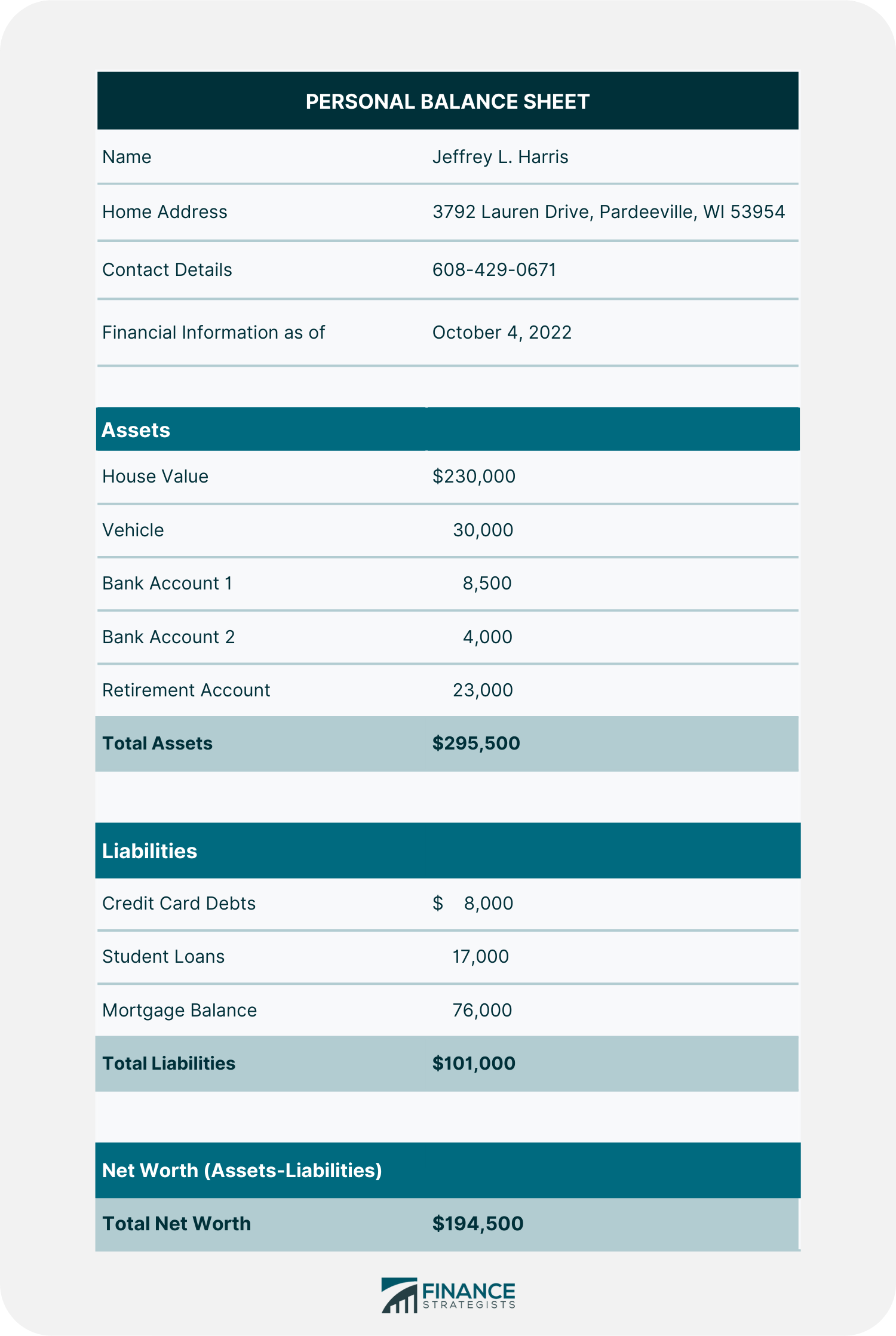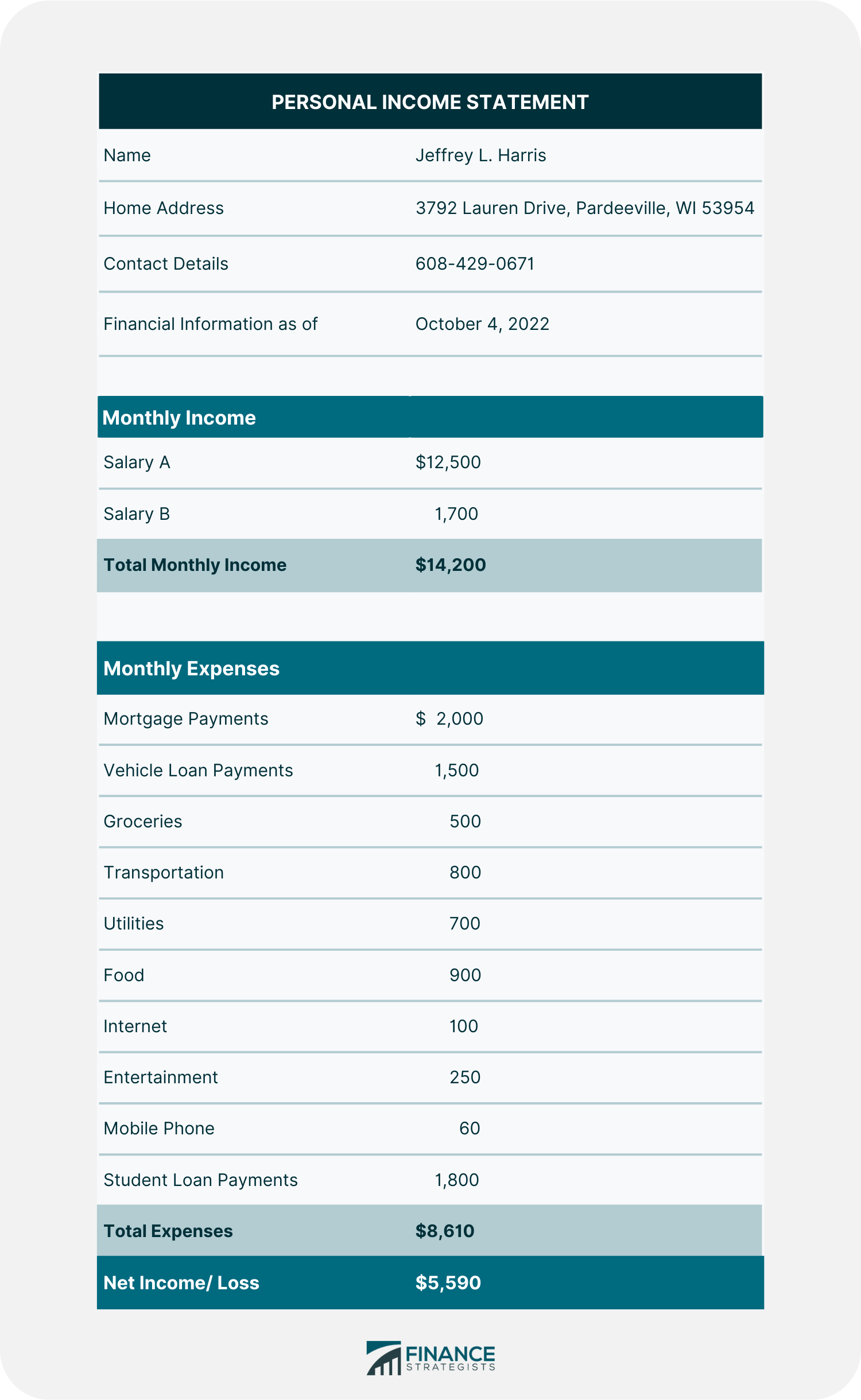

A personal financial statement is a report or set of documents that summarizes an individual's financial situation at a particular time.
It is often divided into two sections: the balance sheet and the income statement.
The balance sheet provides a breakdown of assets and liabilities, while the income statement summarizes income and expenses.
General information about an individual, such as name and address, may also be included in a personal financial statement.
Individuals can use personal financial statements to monitor their current economic situation.
A personal financial statement is typically divided into two sections. These are:
The financial statement contains a section known as a balance sheet, which summarizes a person's assets, including cash and investments, and liabilities like debts or loans.
The balance sheet is also used to calculate an individual’s net worth, which is the value of assets minus the amount of liabilities.

As shown above, Jeffrey has $295,500 worth of assets. This includes the assets like a house, a vehicle, bank accounts, and a retirement account.
Now let us say he has $101,000 in liabilities as well. This includes credit card debts, student loans and mortgages.
With this information, his balance sheet should reflect a net worth of $194,500.
Here is an example of what Jeffrey’s income statement may look like in spreadsheet form:

As shown above, Jeffrey receives a total monthly income of $14,200 and spends a total of $8,610 in expenses.
After subtracting expenses from income, Jeffrey has a net income of $5,590.
Taken together, Jeffrey’s balance sheet and income statement provide useful information about his current financial situation.
Let us look at a guide on how to create a personal financial statement.
Indicate the dollar value of the assets to be declared. Accuracy is important, particularly when creating a statement for the purpose of borrowing.
Find the total value of all available assets.
Liabilities come from debts. State the obligations that have to be settled and debts to be paid.
Common items include credit card debts, mortgage debts, and student loans.
Find the total value of all liabilities.
Net worth is calculated by deducting total liabilities from total assets.
Determine the amount of money coming in from various sources. This usually includes regular income received monthly.
Make a list of all monthly spending. Start with fixed costs before moving to variable costs.
The net profit or loss can be calculated by subtracting the total monthly expenses from the total income or revenue generated in that month.
Here are some reasons why it is important to create a personal financial statement.
A personal financial statement is an important tool that can be used for financial planning.
It provides a snapshot of an individual's financial situation at a particular point in time, which can be helpful in making future projections and plans.
The statement can also be used to track progress over time and to identify areas where improvements can be made.
Personal financial statements are essential when filing taxes because they summarize income made throughout the year.
They also provide an idea of possible deductions that can be made to lower an individual’s tax rate.
Personal financial statements are often required when applying for credit, such as a loan or mortgage.
Lenders use the information in the statement to assess an individual's ability to repay the debt and to determine the interest rate that will be charged.
In some cases, a personal financial statement may be used in lieu of a credit report when applying for credit.
A personal financial statement can be a helpful tool in managing finances and making future plans.
Personal financial statements include balance sheets to monitor assets and liabilities and income statements to track an individual’s income and expenses.
Details on the assets and liabilities related to an individual’s businesses, any rented items and personal belongings are not included in a personal financial statement.
Personal financial statements can be used for a variety of purposes, including financial planning, overviewing an individual's financial situation, and loan applications.
Personal financial statements must be updated on a regular basis to provide an accurate picture of an individual’s current economic situation.
A personal financial statement is a report or set of documents that summarizes an individual's financial situation at a particular time.
A personal financial statement includes information on an individual's balance sheet and income statements. The balance sheet provides a summary of assets and liabilities, whereas the income statement summarizes revenue and costs.
Personal financial statements do not include details of a company’s assets and liabilities, loaned items, and personal belongings.
It is important because it provides a snapshot of an individual's financial situation at a particular point in time. It can help to identify areas where expenses may be excessive or where there is room to make cuts in order to save money. The statement can also be used to track progress toward financial goals.
A personal financial statement shows an individual's assets, liabilities, income, and expenses. It can help to identify areas of financial strength and weakness and to track progress over time.

About the Author
True Tamplin is a published author, public speaker, CEO of UpDigital, and founder of Finance Strategists.
True is a Certified Educator in Personal Finance (CEPF®), author of The Handy Financial Ratios Guide, a member of the Society for Advancing Business Editing and Writing, contributes to his financial education site, Finance Strategists, and has spoken to various financial communities such as the CFA Institute, as well as university students like his Alma mater, Biola University, where he received a bachelor of science in business and data analytics.
To learn more about True, visit his personal website or view his author profiles on Amazon, Nasdaq and Forbes.

WHY WE RECOMMEND:
Fee-only financial advisors are paid a set fee for their services. They do not receive any type of commission from the sale of products they are advising on.
Retirees, Immigrants & Sudden Wealth / Inheritance
Retirement Planning, Personal finance, Goals-based Planning & Community Impact

WHY WE RECOMMEND:
Fee-only financial advisors are paid a set fee for their services. They do not receive any type of commission from the sale of products they are advising on.
Business Owners, Executives & Medical Professionals
Strategic Planning, Alternative Investments, Stock Options & Wealth Preservation
Finance Strategists has an advertising relationship with some of the companies included on this website. We may earn a commission when you click on a link or make a purchase through the links on our site. All of our content is based on objective analysis, and the opinions are our own.
Content sponsored by 11 Financial LLC. 11 Financial is a registered investment adviser located in Lufkin, Texas. 11 Financial may only transact business in those states in which it is registered, or qualifies for an exemption or exclusion from registration requirements. 11 Financial’s website is limited to the dissemination of general information pertaining to its advisory services, together with access to additional investment-related information, publications, and links.
For information pertaining to the registration status of 11 Financial, please contact the state securities regulators for those states in which 11 Financial maintains a registration filing. A copy of 11 Financial’s current written disclosure statement discussing 11 Financial’s business operations, services, and fees is available at the SEC’s investment adviser public information website – www.adviserinfo.sec.gov or from 11 Financial upon written request.
11 Financial does not make any representations or warranties as to the accuracy, timeliness, suitability, completeness, or relevance of any information prepared by any unaffiliated third party, whether linked to 11 Financial’s website or incorporated herein, and takes no responsibility therefor. The articles and research support materials available on this site are educational and are not intended to be investment or tax advice. All such information is provided solely for convenience purposes only and all users thereof should be guided accordingly.
© 2024 Finance Strategists. All rights reserved.
We use cookies to ensure that we give you the best experience on our website. If you continue to use this site we will assume that you are happy with it.